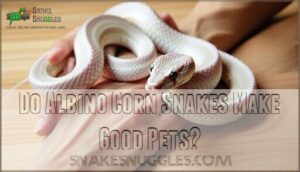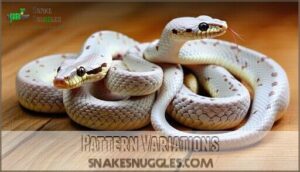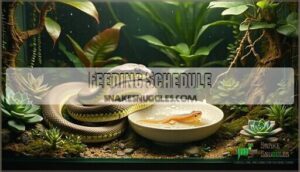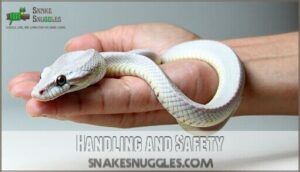This site is supported by our readers. We may earn a commission, at no cost to you, if you purchase through links.
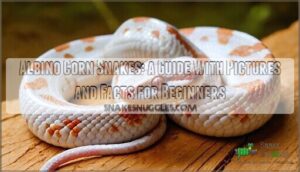 Albino corn snakes make excellent beginner pets with their docile nature and striking appearance.
Albino corn snakes make excellent beginner pets with their docile nature and striking appearance.
You’ll find these beautiful serpents lack dark pigmentation, displaying cream and white bodies with vibrant red or orange patterns and distinctive pink eyes.
They’re surprisingly easy to care for, requiring a 40-gallon tank, temperatures between 75-85°F, and feeding every 5-7 days on appropriately-sized mice.
Their calm temperament means they rarely bite, making handling straightforward once you learn proper techniques.
These snakes typically live 15-20 years and reach 2-5 feet in length.
While their ethereal beauty catches your eye first, their manageable care requirements and gentle personality make them ideal companions.
The genetics behind their stunning coloration involves fascinating breeding considerations that can help you understand what makes each snake unique.
Table Of Contents
- Key Takeaways
- Albino Corn Snake Overview
- Do Albino Corn Snakes Make Good Pets?
- Albino Corn Snake Appearance
- Setting Up Your Habitat
- Feeding Your Albino Corn Snake
- Keeping Your Albino Corn Snake Healthy
- Handling and Safety
- Life Cycle and Breeding
- Cost and Maintenance
- Albino Corn Snake Care Tips
- Frequently Asked Questions (FAQs)
- What are albino corn snakes?
- Do albino corn snakes live long?
- Why do albino corn snakes look different?
- What is the origin of albino corn snakes?
- Are albino corn snakes worth it?
- Are albino corn snakes good pets?
- How do albino corn snakes hunt?
- Do albino corn snakes have health problems?
- What do albino corn snakes eat?
- What are some fun facts about albino corn snakes?
- Conclusion
Key Takeaways
- You’ll find albino corn snakes make excellent beginner pets – they’re docile, rarely bite, and have calm temperaments that make handling straightforward once you learn proper techniques.
- These snakes require surprisingly simple care – you’ll need a 40-gallon tank, temperatures between 75-85°F, and feeding every 5-7 days on appropriately-sized mice.
- You can expect a long-term companion – albino corn snakes typically live 15-20 years and reach 2-5 feet in length, making them rewarding pets for dedicated keepers.
- Their striking appearance comes from fascinating genetics – you’ll see cream and white bodies with vibrant red or orange patterns and distinctive pink eyes due to their lack of melanin pigmentation.
Albino Corn Snake Overview
Discovering the albino corn snake opens a window into fascinating snake genetics and color variants.
These enchanting serpents lack melanin, creating stunning morph types with vibrant orange, red, and white scale patterns. Unlike typical corn snake morphs, albinos showcase ruby-red eyes and brilliant coloration.
With proper habitat needs including escape-proof enclosures and controlled humidity, your albino corn snake lifespan reaches 15-20 years.
These albino snake facts reveal docile temperaments perfect for beginners. Their corn snake genetics create unique individuals through selective breeding, making each snake a living masterpiece of nature’s artistry.
Do Albino Corn Snakes Make Good Pets?
Choosing an albino corn snake for pet ownership opens doors to a rewarding reptile experience. These snakes excel as beginner-friendly pets due to their docile temperament and straightforward care requirements.
You’ll find their calm nature makes handling tips easy to master – they rarely bite and adapt well to gentle, consistent interaction. Snake behavior in albino corn snakes remains predictable and manageable.
They’re naturally curious yet non-aggressive, making them suitable for families with children. Their nocturnal activity patterns mean you’ll observe fascinating behaviors during evening hours.
Pet suitability ratings consistently rank corn snake care as beginner-level. Care requirements include proper heating, humidity control, and weekly feeding schedules. This reptile pet guide emphasizes their impressive 15-20 year albino corn snake lifespan, ensuring long-term companionship.
Initial setup costs may seem significant, but ongoing maintenance remains affordable. Regular veterinary check-ups and consistent snake handling tips will keep your scaled companion healthy and content for decades.
Albino Corn Snake Appearance
You’ll notice that albino corn snakes stand out with their striking lack of dark pigment, creating beautiful red, orange, and white patterns that make them instantly recognizable.
Their ruby-red eyes and corn kernel-like belly scales give them a unique appearance that’s both enchanting and scientifically fascinating, with a striking visual effect due to their albino characteristics.
Physical Characteristics
Albino corn snakes showcase striking physical traits that make them enchanting pets.
Their serpents reach 2-6 feet in body length with slender builds weighing around one pound.
Their keeled scales create distinctive skin texture, while scale patterns display alternating red and orange saddle markings bordered by white.
The checkerboard belly resembles corn kernels, giving these snake morphs their common name.
Most remarkably, their eye colors range from ruby red to fiery orange, a hallmark of albino genetics that sets them apart from other snake colors and snake patterns found in nature, with distinctive skin texture.
Color Morphs
When exploring albino corn snake morphs, you’ll discover a fascinating world of snake pigmentation.
These color variations showcase incredible morph genetics, creating stunning visual combinations that captivate reptile enthusiasts worldwide.
Popular albino corn snake morphs include:
- Snow morphs – combining albino and anerythristic traits for pale beauty
- Butter morphs – blending caramel genetics with classic albino patterns
- Scaleless albinos – featuring smooth skin without traditional scale colors
- Striped albinos – displaying linear patterns instead of saddle markings
- Reverse Okeetee – intensified red and orange hues with thick borders
Understanding the role of genetic color morphs is essential in appreciating the diversity of albino corn snake appearances.
Pattern Variations
Beyond their striking color morphs, albino corn snakes showcase fascinating saddle patterns that make each snake unique.
These saddle markings appear as distinctive blotches along their backs, bordered by white or cream edges. Head markings create spear-shaped designs that vary dramatically between individuals.
Belly markings display the characteristic checkerboard pattern resembling corn kernels. Color intensity differs among unique morphs like the Snow Corn Snake, which combines albino traits with other genetics.
Snake morph types include Scaleless and Striped variations. Each albino morph represents distinct genetic combinations, creating endless pattern possibilities.
Setting Up Your Habitat
Creating the perfect home for your albino corn snake isn’t complicated, but getting the details right makes all the difference for your snake’s health and happiness.
You’ll need to examine four key elements: tank size, temperature control, humidity levels, and enrichment items that keep your snake comfortable and engaged.
Tank Size and Type
Your snake’s enclosure dimensions matter more than you might think. A 40-gallon aquarium provides adequate space for adult albino corn snakes, though larger is always better.
Space matters most—your snake needs room to thrive, not just survive.
Your secure lid prevents escape attempts—these snakes are surprisingly crafty! Consider DIY enclosures for custom sizing, but guarantee proper ventilation.
Glass vs. plastic both work well, but glass offers superior ventilation and durability. Tank enrichment starts with choosing the right foundation.
Many owners find aquarium supplies online for their snake’s habitat. Whether you select a standard snake enclosure setup or custom corn snake habitat, prioritize escape-proof design with mesh tops for airflow and snake tank accessories compatibility.
Temperature and Lighting
With your tank ready, you’ll need proper temperature and lighting to keep your snake healthy.
Create a heat gradient with a basking spot at 85-90°F using an adjustable heat bulb.
Skip UVB lighting—albino corn snakes don’t need it and their sensitive eyes prefer darkness.
Allow night temperatures to drop 5-10°F for natural comfort cycles.
Humidity and Substrate
Your snake’s comfort hinges on proper humidity levels between 65-75% and suitable substrate types. Choose moisture-retaining options like coconut fiber or aspen shavings for ideal snake humidity control.
Maintain substrate depth of 2-3 inches to support burrowing behavior while preventing shedding issues.
- Substrate Types: Coconut fiber retains moisture better than aspen shavings for consistent humidity
- Humidity Levels: Use a digital hygrometer to monitor and maintain 65-75% consistently
- Mold Prevention: Replace substrate every 4-6 weeks and spot-clean waste immediately
- Snake Substrate Cost: Budget $15-25 monthly for quality substrate replacement and maintenance
- Burrowing Behavior: Provide 2-3 inches depth so your snake can tunnel and feel secure
Hides and Decorations
Your snake needs Safe Hides on both warm and cool sides of the enclosure for security.
Add Climbing Decor like branches or cork bark to encourage natural behaviors.
Include Enrichment Items such as artificial plants for a Naturalistic Setup.
Secure all tank setup decorations to prevent injuries.
Choose smooth items that won’t snag scales, and regularly inspect Cleaning Decor during habitat maintenance.
Consider using appropriate hiding structures to reduce snake stress.
Feeding Your Albino Corn Snake
Feeding your albino corn snake properly is essential for their health and development throughout their 15-20 year lifespan.
You’ll need to understand the right prey size, feeding frequency, and nutritional supplements to keep your snake thriving.
Prey Size and Type
Choosing proper rodent size guarantees your snake’s health and safety. Pick prekilled mice matching your snake’s widest body section—oversized prey causes serious problems.
- Hatchlings: Pinkie mice under 3 grams
- Juveniles: Fuzzy mice weighing 3-7 grams
- Adults: Adult mice around 20-30 grams
- Safety first: Frozen mice prevent injuries from live prey
Frozen vs. live isn’t even close—frozen wins every time for nutritional value and snake safety.
Feeding Schedule
Your albino corn snake’s feeding schedule varies by age.
Hatchlings need prekilled mice every 5-7 days, while juveniles eat weekly.
Adult intervals stretch to 10-21 days between meals.
This juvenile frequency prevents obesity and regurgitation causes like overfeeding.
Consistent snake feeding schedules keep your albino corn snakes healthy and thriving on their snake diet.
Supplemental Vitamins and Minerals
Your snake’s nutritional needs go beyond just mice. While whole prey provides most nutrients, calcium supplementation and vitamin D3 can help prevent nutritional deficiencies.
Dust prey with calcium supplements occasionally, focusing on mineral balance rather than routine dosing. Create a supplement schedule based on your snake’s age and health needs.
Understanding proper corn snake feeding techniques is vital for maintaining healthy health.
Key supplementation considerations:
- Snake diet quality affects supplement needs – varied prey reduces deficiency risk
- Snake health improves with balanced calcium-to-phosphorus ratios in food
- Young snakes need more frequent supplementation during rapid growth periods
- Over-supplementation can cause kidney problems and digestive issues
- Gut-loaded prey offers natural vitamin content without artificial additives
Keeping Your Albino Corn Snake Healthy
Keeping your albino corn snake healthy means watching for warning signs and acting quickly when problems arise.
Regular observation and preventive care will help your snake live its full 15-20 year lifespan with minimal health complications.
Common Health Issues
Proper feeding sets the foundation, but staying alert to health problems keeps your snake thriving.
Respiratory infections affect over 30% of captive corn snakes, showing up as wheezing or mouth rot with pus-filled lesions.
Parasites like mites cause restlessness and anemia in 12% of pet snakes.
Shedding problems from low humidity create stuck skin that can damage eyes.
Poor husbandry increases infection prevention challenges, making regular habitat cleaning your best defense against these albino corn snake health issues.
Signs of Illness
Even the healthiest albino corn snake can show subtle signs of illness, so don’t ignore the little things.
Keep an eye out for:
- Lethargy or hiding more than usual
- Appetite loss or refusing food
- Shedding problems, like stuck skin
- Wheezing or mucus around the mouth
Spotting snake signs of illness early helps with Mouth Rot, Respiratory Issues, and Parasite Control, ensuring overall snake health.
Veterinary Care
Professional veterinary visits form the cornerstone of albino corn snake health.
Schedule annual health checks to catch snake health issues early, including parasite control and disease prevention.
Your vet can spot snake signs of illness you might miss and provide proper medical treatment.
Regular veterinary visits help prevent costly snake common health issues, and professional snake veterinary care guarantees your pet thrives, making that albino corn snake price a worthwhile investment.
Handling and Safety
You’ll want to handle your albino corn snake properly to keep both of you safe and comfortable.
These gentle snakes rarely bite when handled correctly, but knowing the right techniques prevents stress and builds trust between you and your pet.
Handling Techniques
Moving from health concerns to hands-on care, gentle handling creates positive snake handling sessions.
Support your snake’s body with both hands, letting it move naturally between your palms.
These snake safe handling techniques work best with calm personalities like albinos.
Move slowly and provide steady snake support throughout each interaction.
Handling tools aren’t necessary—your hands offer the best connection and control for successful safety measures.
Safety Precautions
Safe snake handling techniques protect both you and your albino corn snake from unnecessary stress and potential snake bites.
Here are three essential safety precautions for handling risks and escape prevention:
- Wash hands thoroughly before and after handling to prevent salmonella transmission and remove strong scents
- Move slowly and deliberately – quick movements can startle your snake and trigger defensive responses
- Secure all enclosure latches properly to guarantee effective escape prevention and maintain a controlled environment
Emergency procedures aren’t typically needed since albino corn snakes lack venom, but gentle handling techniques create positive experiences for everyone involved.
Snake Behavior
Most albino corn snakes display docile nature and predictable patterns that make snake handling straightforward for beginners.
Their nocturnal habits mean they’re most active during evening hours, showing natural hunting tactics like striking and constricting motions during feeding time.
You’ll notice their impressive climbing ability as they explore branches and decorations in their habitat.
Social interactions aren’t their forte—they prefer solitude over companionship.
When stressed, their escape behavior involves seeking dark, enclosed spaces.
Understanding corn snake temperament helps you recognize normal behaviors versus signs of distress, making your snake behavior observations more meaningful and your handling sessions more successful.
Life Cycle and Breeding
Understanding albino corn snakes’ life cycle helps you plan for long-term care and potential breeding projects.
These beautiful serpents can live 15-20 years in captivity and reach sexual maturity around 18-24 months of age.
Lifespan
When properly cared for, your albino corn snake can become a long-term companion with an average lifespan of 15-20 years.
Several longevity factors directly impact how long these beautiful snake morphs thrive in captivity:
- Consistent nutrition – proper feeding schedules prevent health issues
- Clean environment – regular habitat maintenance reduces mortality rates
- Preventive care – routine vet visits catch problems early
Quality corn snake care substantially extends their aging process naturally.
Understanding ball python lifespan factors can also inform corn snake care decisions.
Breeding Habits
Your albino corn snake reaches sexual maturity around 16-24 months, when breeding seasons begin. Spring marks prime mating rituals time, typically March through June.
Males become restless, refusing food while searching for females. During courtship, they align bodies and use tactile cues to stimulate partners.
Genetic selection matters – choose healthy breeding pairs free from defects. Successful corn snake breeding requires proper conditioning, including winter cooling periods.
Multiple matings over several days increase fertilization success. Reptile breeding tips include monitoring female receptivity and providing ideal environmental conditions for albino morphs.
Understanding the colubridae family traits is essential for breeding albino corn snakes.
Egg-Laying and Incubation
After successful mating during breeding seasons, female albino corn snakes begin egg formation within their bodies. You’ll notice your female becoming noticeably thicker as eggs develop over several weeks. She’ll seek out warm, humid spots and may refuse food during this time.
Once ready for egg laying, your snake will deposit 5-20 leathery white eggs in her nesting boxes. Each egg measures about one inch long and feels soft to touch. Incubation takes 50-70 days at consistent temperatures between 80-85°F.
Here are essential incubation tips for successful hatchling care:
- Maintain steady humidity at 85-90% using damp vermiculite substrate
- Keep temperature constant using a reliable reptile incubator
- Mark egg tops before moving to prevent rotation damage
- Check weekly for mold or collapsed eggs without excessive handling
Your patience during incubation pays off when tiny corn snakes emerge ready to start their independent lives.
Cost and Maintenance
You’ll need to budget carefully when getting an albino corn snake since the initial setup can cost several hundred dollars for proper equipment.
The good news is that ongoing costs stay pretty low with just monthly food expenses and occasional substrate changes, which helps with budgeting.
Initial Setup Costs
Getting your albino corn snake settled will cost more upfront than you might expect, but it’s worth every penny.
You’ll spend the most on Tank Costs – expect $45-300 for an adult-sized enclosure depending on whether you choose glass or premium materials.
Heating Expenses run $33-130 for heat pads and thermostats to maintain that perfect temperature gradient.
Substrate Prices stay reasonable at $10-30 per bag, while Hide Boxes add another $30-60 for multiple retreats.
Don’t forget Ventilation Systems and monitoring equipment, which typically run $20-40 total.
The overall cost of owning an albino corn snake can be estimated by considering corn snake prices.
Enclosure size
Tank accessories
Heating equipment
Substrate cost
Food expenses
Ongoing Maintenance Costs
Most pet owners find that ongoing maintenance costs add up quickly. Your Food Expenses will be your biggest recurring cost, with frozen mice ranging from $1-3 each.
Veterinary Care typically runs $50-150 per annual checkup, plus emergency visits if needed. Habitat Upkeep includes monthly substrate replacement ($10-20) and Equipment Replacement for worn heating elements or broken decorations.
Here are the main snake maintenance costs you’ll face:
- Snake food expenses – Monthly feeding supplies cost $10-25 for frozen prey
- Snake heating costs – Electricity for heat sources adds $5-15 monthly to utility bills
- Snake enclosure maintenance – Cleaning supplies and substrate replacement run $15-30 monthly
- Equipment upkeep – Annual replacement of thermometers, heating pads, or Feeding Supplies averages $25-50
Budget around $50-100 monthly for total snake cost maintenance. Understanding proper snake food options is essential for maintaining a healthy pet snake.
Time Commitment
An albino corn snake’s time commitment fits most busy schedules perfectly.
Daily care involves checking temperatures and water, while feeding schedule runs weekly for adults.
Here’s your typical routine:
- Daily monitoring: Quick 5-minute habitat checks for proper heating and fresh water
- Weekly feeding sessions: 15 minutes preparing and offering pre-killed mice
- Monthly deep cleaning: Hour-long tank sanitization and substrate replacement
This snake care routine demands consistent owner dedication but won’t overwhelm your calendar.
Albino Corn Snake Care Tips
You’ll get the most out of your albino corn snake by following a few key care practices that keep them healthy and happy.
These tips cover the essentials of habitat maintenance, proper feeding techniques, and safe handling methods that work well for both new and experienced snake owners.
Habitat Maintenance
Think of your albino corn snake’s habitat as a cozy retreat that needs regular upkeep. Tank cleaning happens weekly—remove waste and spot-clean water dishes to prevent bacteria buildup.
Change substrate options like aspen shavings monthly, using a small vacuum for easy cleanup. Humidity control requires weekly monitoring with a digital hygrometer. Mist lightly if levels drop below 40-50%.
Check ventilation systems to confirm proper airflow without creating drafts. Temperature gradients need daily verification—use infrared thermometers to confirm your heating elements maintain 75-85°F ranges.
Reposition hides monthly to create mental stimulation. Your snake habitat benefits from annual upgrades like new climbing branches or textured surfaces. Enclosure maintenance becomes routine once you establish a schedule.
Quality reptile pet supplies last longer and make snake enclosure setup more efficient. The following table outlines key tasks:
new adventure.
interesting.
The table provides a quick reference for maintenance tasks, including weekly monitoring and monthly upkeep. By following these guidelines, you can create a comfortable and stimulating environment for your albino corn snake, ensuring its health and happiness through proper habitat maintenance and regular upkeep.
Feeding Tips
Success starts with smart feeding habits. Your snake’s health depends on proper nutrition and timing.
- Prey Size: Match rodent width to your snake’s thickest body section for safe swallowing
- Feeding Schedule: Feed juveniles every 5-7 days, adults every 10-21 days based on age
- Meal Frequency: Adjust portions according to your snake’s growth stage and activity level
- Supplement Tips: Dust occasional meals with calcium powder and vitamin D3 for bone health
Handling Tips
Handling your albino corn snake properly builds trust and prevents stress.
Support their entire body with both hands, moving slowly to avoid startling them.
Handle 1-2 times weekly for 10-15 minutes, avoiding the 48 hours after feeding.
| Do | Don’t |
|---|---|
| Support full body length | Grab near the tail |
| Move slowly and calmly | Handle during shedding |
| Wash hands before/after | Use sudden movements |
| Handle in evening hours | Squeeze or grip tightly |
Watch for rapid tongue flicking or defensive posturing—these signal it’s time to return your snake to its enclosure.
Frequently Asked Questions (FAQs)
What are albino corn snakes?
You’ll discover these fascinating snakes are corn snakes lacking melanin, creating stunning red, orange, and white patterns with ruby-red eyes instead of typical dark coloration.
Do albino corn snakes live long?
Here’s what surprises many snake lovers: your albino corn snake can be your companion for decades.
These beautiful serpents typically live 15-20 years with proper care, temperature control, and regular feeding schedules.
Why do albino corn snakes look different?
You’ll notice albino corn snakes lack melanin, the pigment that creates dark colors.
This genetic mutation eliminates blacks and browns, leaving behind striking reds, oranges, whites, and yellows with ruby-red eyes.
What is the origin of albino corn snakes?
Like a genetic lottery ticket, you’ll find albino corn snakes aren’t found in nature’s wild playground.
These stunning serpents originated through selective breeding programs where dedicated breeders carefully paired snakes carrying the amelanistic gene mutation, creating these enchanting creatures.
Are albino corn snakes worth it?
You’ll find albino corn snakes rewarding pets since they’re docile, low-maintenance, and live 15-20 years.
They’re perfect for beginners, requiring minimal care while offering stunning beauty and gentle temperaments that make handling enjoyable.
Are albino corn snakes good pets?
Docile, hardy, and beginner-friendly, you’ll find albino corn snakes make excellent pets. They’re calm, rarely bite, adapt well to handling, and thrive with basic care requirements.
How do albino corn snakes hunt?
Albino corn snakes use constriction hunting, relying on heat-sensing abilities and keen eyesight to locate prey. You’ll see them strike quickly, coiling around rodents to suffocate them before swallowing whole.
Do albino corn snakes have health problems?
Studies show 15-20% of albino corn snakes face health challenges, but you’ll find they’re generally hardy pets.
Common issues include bacterial infections, shedding problems, and parasites—all preventable with proper care and hygiene.
What do albino corn snakes eat?
You’ll feed your albino corn snake pre-killed mice sized to match the snake’s thickest body part. Juveniles eat weekly, while adults need feeding every 10-21 days for ideal health.
What are some fun facts about albino corn snakes?
Beneath their striking ruby eyes lies nature’s clever disguise.
You’ll discover these snakes help farmers by hunting crop-damaging rodents, earning them the nickname "red rat snakes" while living up to 20 years in captivity.
Conclusion
Picture yourself watching your albino corn snake gracefully glide through its habitat, those striking pink eyes catching the light as it explores.
You’ve now learned everything needed to provide excellent care for these remarkable reptiles.
From proper heating and feeding schedules to gentle handling techniques, albino corn snakes make rewarding pets for dedicated keepers.
Their docile nature and manageable requirements prove why this albino corn snakes guide with pictures and facts remains essential for beginners.
With commitment and proper knowledge, you’ll enjoy years of fascinating companionship.
- https://animaldiversity.org/accounts/Pantherophis_guttatus/
- https://www.doc-developpement-durable.org/file/Elevages/Serpents/serpent-des-bles/The%20Corn%20Snake%20Guide.pdf
- https://www.herps-and-inverts.com/understanding-corn-snake-behaviour/
- https://www.hartmanreserve.org/corn-snake.html
- https://www.reddit.com/r/cornsnakes/comments/1ap10mt/to_everyone_breeding_season_is_starting_behavior/

